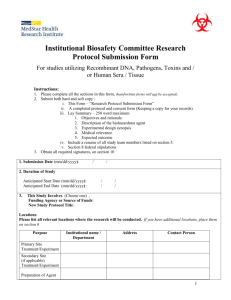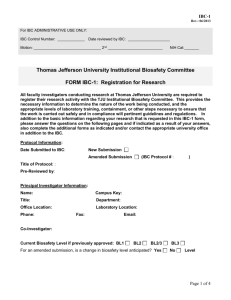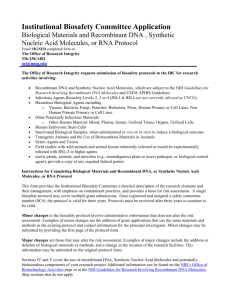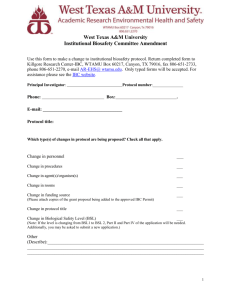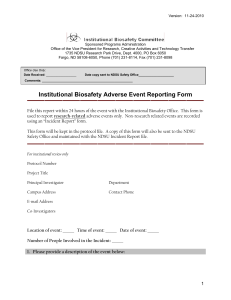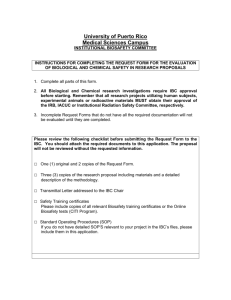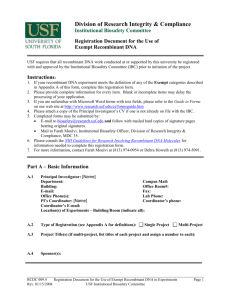SYNOPSIS OF RECOMBINANT DNA GUIDELINES AND
advertisement
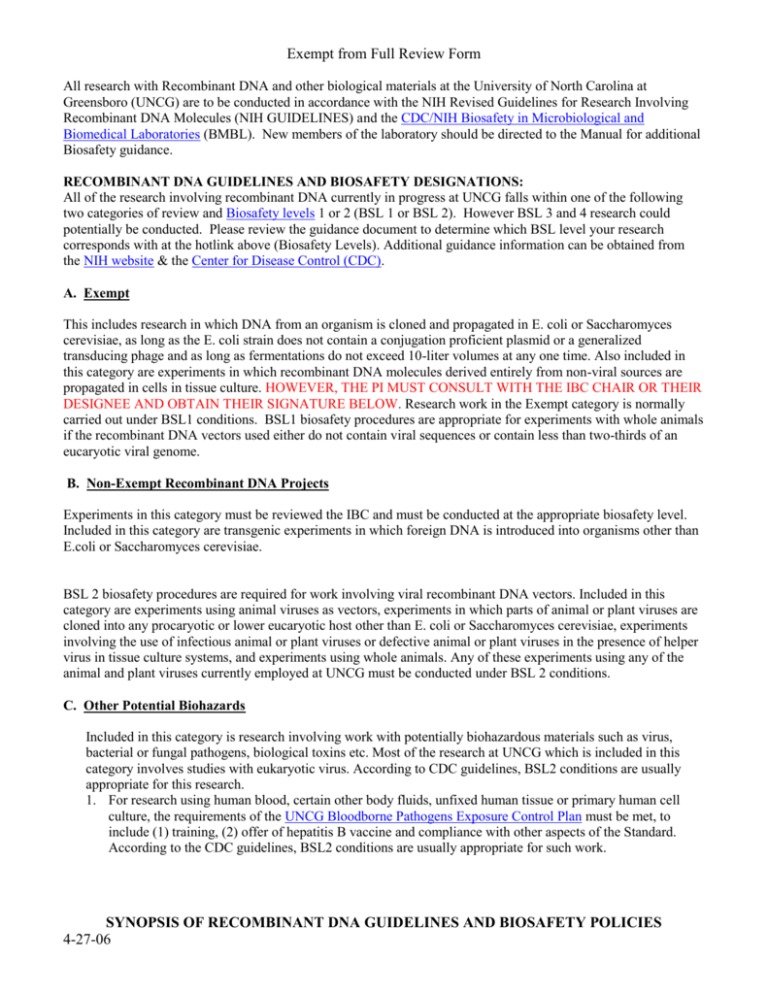
Exempt from Full Review Form All research with Recombinant DNA and other biological materials at the University of North Carolina at Greensboro (UNCG) are to be conducted in accordance with the NIH Revised Guidelines for Research Involving Recombinant DNA Molecules (NIH GUIDELINES) and the CDC/NIH Biosafety in Microbiological and Biomedical Laboratories (BMBL). New members of the laboratory should be directed to the Manual for additional Biosafety guidance. RECOMBINANT DNA GUIDELINES AND BIOSAFETY DESIGNATIONS: All of the research involving recombinant DNA currently in progress at UNCG falls within one of the following two categories of review and Biosafety levels 1 or 2 (BSL 1 or BSL 2). However BSL 3 and 4 research could potentially be conducted. Please review the guidance document to determine which BSL level your research corresponds with at the hotlink above (Biosafety Levels). Additional guidance information can be obtained from the NIH website & the Center for Disease Control (CDC). A. Exempt This includes research in which DNA from an organism is cloned and propagated in E. coli or Saccharomyces cerevisiae, as long as the E. coli strain does not contain a conjugation proficient plasmid or a generalized transducing phage and as long as fermentations do not exceed 10-liter volumes at any one time. Also included in this category are experiments in which recombinant DNA molecules derived entirely from non-viral sources are propagated in cells in tissue culture. HOWEVER, THE PI MUST CONSULT WITH THE IBC CHAIR OR THEIR DESIGNEE AND OBTAIN THEIR SIGNATURE BELOW. Research work in the Exempt category is normally carried out under BSL1 conditions. BSL1 biosafety procedures are appropriate for experiments with whole animals if the recombinant DNA vectors used either do not contain viral sequences or contain less than two-thirds of an eucaryotic viral genome. B. Non-Exempt Recombinant DNA Projects Experiments in this category must be reviewed the IBC and must be conducted at the appropriate biosafety level. Included in this category are transgenic experiments in which foreign DNA is introduced into organisms other than E.coli or Saccharomyces cerevisiae. BSL 2 biosafety procedures are required for work involving viral recombinant DNA vectors. Included in this category are experiments using animal viruses as vectors, experiments in which parts of animal or plant viruses are cloned into any procaryotic or lower eucaryotic host other than E. coli or Saccharomyces cerevisiae, experiments involving the use of infectious animal or plant viruses or defective animal or plant viruses in the presence of helper virus in tissue culture systems, and experiments using whole animals. Any of these experiments using any of the animal and plant viruses currently employed at UNCG must be conducted under BSL 2 conditions. C. Other Potential Biohazards Included in this category is research involving work with potentially biohazardous materials such as virus, bacterial or fungal pathogens, biological toxins etc. Most of the research at UNCG which is included in this category involves studies with eukaryotic virus. According to CDC guidelines, BSL2 conditions are usually appropriate for this research. 1. For research using human blood, certain other body fluids, unfixed human tissue or primary human cell culture, the requirements of the UNCG Bloodborne Pathogens Exposure Control Plan must be met, to include (1) training, (2) offer of hepatitis B vaccine and compliance with other aspects of the Standard. According to the CDC guidelines, BSL2 conditions are usually appropriate for such work. SYNOPSIS OF RECOMBINANT DNA GUIDELINES AND BIOSAFETY POLICIES 4-27-06 Exempt from Full Review Form GENERAL INFORMATION Principal Investigator____________________________________ Department____________________________________________ Phone Number ________________________________________ Funding Source ________________________________________ Project Title ___________________________________________ ______________________________________________________ HAZARDS ASSOCIATED WITH PROJECT Radionuclides – If yes, please submit a separate application to the Radiation Safety Committee Hazardous Chemicals – If yes, MSDS should be available upon request. In the event that MSDS are not available you will need to be able to provide a list specifying each hazardous chemical to be used in the project including information regarding hazard category using the following annotations: HEALTH HAZARDS: C= carcinogen (known or suspected); T= teratogen; M= mutagen; N= nephrotoxin; Nr= neurotoxin; H= hepatoxin; and Hm= hematopoetic toxin. PHYSICAL HAZARDS: F= flammable; R= reactive; O= oxidizer; and Co= corrosive. Researchers and employees using hazardous chemicals must be trained in accordance with the UNCG Chemical Hygiene Plan and Hazardous Waste Program Recombinant DNA: _____BL 1 Human Tissue/Fluids Etiologic Agents _____BL 1 Animals – If yes, please submit a separate application to the Institutional Animal Care and Use Committee Transgenic Animals: Specify species CLASSIFICATION OF RISK _____RL 1 Note: The BL and RL can be not greater than 1 to qualify for an exemption RESEARCH SUMMARY The research summary should including how agent will used, training for all individuals, lab BL level, and any processes that will be conducted. Consultation for signage can be obtained through the Office of Safety. Include this information on a separate sheet(s) which should not exceed 3 pages. SYNOPSIS OF RECOMBINANT DNA GUIDELINES AND BIOSAFETY POLICIES 4-27-06 Exempt from Full Review Form Projects Requiring Concurrent IBC Registration: (BL1) Proposed Start Date:______________End Date______________ I have read, understand, and agree to abide by the institutional/federal regulations when working with the hazardous agents described therein. I understand the nature of the hazard associated with the agent(s) under this protocol. I understand that disregard for the policies and procedures as outlined in this protocol could result in dismissal from work with the designated hazardous agents. ______________________________________ Date ____________ On behalf of the IBC I concur that this research is exempt under category A (Exempt). _______________________________________ Date _____________ I have read this document inclusive of all supporting information and deem this research as non-exempt under category B. I will initiate IBC approval by completing the IBC form and forwarding this document to the Office of Research Integrity at ori@uncg.edu. _______________________________________ Date ___________ SYNOPSIS OF RECOMBINANT DNA GUIDELINES AND BIOSAFETY POLICIES 4-27-06

